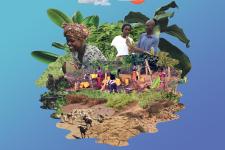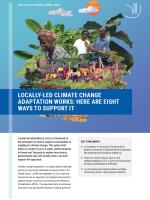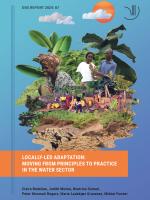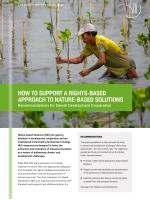Locally-led climate change adaptation works: Here are eight ways to support it

- LLA projects in Kenya and Tanzania show positive outcomes, indicating that the approach has potential and should be scaled up.
- There is a need to focus more on the institutionalisation of LLA, and on ensuring that funding is predictable and flexible.
- LLA provides good opportunities to employ community-driven, nature-based solutions.
Locally-led adaptation (LLA) is a framework of key principles for how to support communities in adapting to climate change. This policy brief looks at a study of six LLA water-related projects in Kenya and Tanzania to explore how donors, governments and civil society actors can best support the approach.
Climate change adaptation is a major global challenge and key to securing livelihoods and economies in the Global South. Locally-led adaptation (LLA) is gaining momentum as an approach to integrate local context, address equity concerns, and enhance the efficiency of adaptation efforts. The approach aims to empower local actors by giving them decision-making authority over climate funds, resulting in solutions better tailored to local conditions. The approach is guided by the ‘LLA principles’, a set of eight principles endorsed by over 120 organisations globally, to ensure that adaptation approaches are effective, equitable and transparent (Box 1). The principles were further endorsed by multiple partners at the 2023 United Nations Climate Change Conference (COP28).
Until now, there has been limited knowledge on how LLA implementation is experienced on the ground, especially in relation to water, which is critical in adaptation. In order to address this, a study involving researchers from DIIS, Kenyatta University and University of Dar es Salaam explored LLA in water adaptation initiatives in East Africa’s drylands. The study examined progress in six water adaptation projects in Kenya and Tanzania (Box 2), aiming to understand their progress in relation to the eight LLA principles, plus a further principle on applying ‘Nature-based Solutions’ (Box 3) to adaptation. A full report on the study can be found in the DIIS Report ‘Locally-Led Adaptation: Moving from Principles to Practice in the Water Sector’ (Bedelian et al 2024). The report includes in-depth case studies which complement the recommendations below.
The study’s positive outcomes indicate the potential of LLA as an approach to climate change adaptation. Donors, governments and civil society actors can help support LLA as follows:
- Devolving decision-making to the lowest appropriate level
- Addressing structural inequalities faced by women, youth, children, disabled and displaced people, Indigenous Peoples and marginalised ethnic groups
- Providing patient and predictable funding that can be accessed more easily
- Investing in local capabilities to leave an institutional legacy
- Building a robust understanding of climate risk and uncertainty
- Flexible programming and learning
- Ensuring transparency and accountability
- Collaborative action and investment
Scale up the LLA principles in water adaptation
The study found a number of positive outcomes from the examined LLA projects in the water sector, indicating that the approach has potential and that the LLA principles are sound. The approach in the projects investigated furthermore have potential for scaling up. There is a need for supportive funding to sustain the momentum and expand to nationwide coverage. This is also the case in other regions, where LLA is less developed and piloting is required.
Mainstream locally-led water adaptation into wider land-use and development planning
The projects studied were primarily planned as stand-alone projects, without significant integration into broader land use plans at local government level and above. This poses a challenge, as a project-centred or sector-specific focus may be influenced or overridden by interventions or policies in other sectors. An emphasis on mainstreaming locally-led water adaptation into broader policies and planning processes is therefore needed. It is important to ensure that this integration does not complicate or impose a top-down bureaucratic planning process, and instead use a bottom-up approach.
Address the predictability of funding
In all the cases studied, stakeholders expressed concern over long-term funding predictability and dependency on international funding with short project timeframes. For example, water investments in drylands are often planned as one-off interventions but need continuous investment cycles if they are to remain functional through regular climate shocks and be sustainable in the long term. There is a need to devise long-term institutionalised financing strategies to cover continuous investments and recurrent costs. The County Climate Change Funds in Kenya are a promising (though so far limited) example of regularized local government co-funding. Further efforts to increase devolved funding from national budgets to support LLA are needed. Mechanisms that pool donor funds to provide long-term international funding commitments or leverage international climate funds can also help enhance regular and sustained funding. The WSTF in Kenya is a sector-specific fund that focuses on securing consistent funding for water-related adaptation projects; strengthening such funds ensures targeted support for LLA initiatives within the water sector.
- Local Climate Adaptive Living Facility (LoCAL). An international performance-based grant facility. Two projects studied in Tanzania.
- County Climate Change Funds (CCCF). A subnational devolved fund in Kenya. Three projects studied.
- Water Services Trust Fund (WSTF). A national water fund in Kenya. One project studied.
Provide flexible budgetary allocations for adaptation financing
There is a need to reduce restrictions and detailed earmarking on funding for LLA. It makes good sense to track and mark finance at the overall level (through the Rio markers, etc), and earmark funds for ‘climate change adaptation’ at the local government level. However, if the earmarking of funding is too rigid, it can reduce its effectiveness. By predetermining in detail what can be funded, the potential for adaptive management and innovate solutions is reduced. Detailed earmarking can further constrain local governments’ efforts to plan holistically and may lead to project islands. Restrictive funding procedures can be particularly detrimental to the most vulnerable – for example, community members who need urgent support to restore water systems during drought or flooding. Support to water-related LLA should therefore allow quick and cross-sectoral disbursement; provide for contingency- and emergency funds, and be based on simple, transparent procedures for bottom-up proposals and approval. The benefits of such an approach in terms of adaptive planning and execution outweigh the risks involved.
Strengthen the institutionalisation of LLA
The study found positive developments in participatory decision-making in the cases examined. This was particularly so in the Kenyan cases, where inclusive decision-making in LLA processes have been institutionalised and integrated within local governance institutions for water management. In settings where local governance mechanisms are very weak (for example, in highly autocratic or volatile/post-conflict settings in other regions), institutionalisation may need to be achieved in other ways through, for example, community-based organisations and non-governmental organisations, or a mix of public and civil society arrangements. There is furthermore a need to deepen the inclusion of marginalised groups so that their adaptation strategies are not overlooked or overruled by other local groups. This can be done by drawing on, for example, the CCCF mechanism’s practices for representation. Rather than assuming that everyone’s water needs and adaptation strategies are similar, both the development and planning stage, as well as the monitoring and evaluation stage, should allow for a multi-stakeholder perspective
Build local capacities for sustainable water management
The study highlighted the importance of ensuring LLA sustainability beyond the lifespan of a particular project. This could include the preparation of sustainability plans for water investments at the proposal stage, and adopting a blended funding approach that leverages diverse funding sources. It is also key to consider long-term technical training for local governments and community water management committees. It is also good to promote a skilled private sector, and tailor the choice of water infrastructure and associated technologies to the user groups based on their knowledge, needs and available resources.
Nature-based solutions are actions to protect, restore and sustainably use ecosystems in order to address social and environmental challenges, including climate change adaptation. Examples from the LLA projects studied include wetland restoration, rainwater harvesting, soil moisture conservation, sand dams, sustainable tree planting, and protecting natural water retention areas.
Facilitate a locally driven approach to nature-based solutions
Well-functioning ecosystems are key to the livelihoods of many communities and critical to their adaptation options. Employing nature-based solutions to enhance water-related adaptation is an obvious opportunity, particularly in relation to LLA. Such activities should be locally driven and integrated within the wider LLA process, and should not disenfranchise communities in terms of water use rights, or marginalise poor households through, for example, water user fees that they cannot pay. The International Union of Conservation of Nature’s ‘Global Standard for Nature-based Solutions’ provides indicators on inclusion and rights that can help monitor these issues. Activities aimed at nature-based solutions should provide space for inclusive stakeholder negotiation and conflict resolution and consider the diverse needs of different water users within the broader LLA process.
Enhance capacity and knowledge co-production in LLA
Managing water for adaptation is a knowledge-intensive task. Diverse adaptation strategies, hydrological dynamics and upstream-downstream interactions require knowledge and planning at various scales. Employing nature-based solutions furthermore requires understanding of the interactions between green and grey water infrastructure. Communities have strong indigenous and practice-based knowledge about local ecosystems, which can be employed alongside specialist technical insights on, for example, hydrological flows and ecosystem dynamics. Mechanisms for collaborative knowledge production involving communities, local governments and technical specialists should be employed in LLA, alongside participatory vulnerability assessments as well as monitoring and evaluation. The report accompanying this brief provides a framework which could be adapted by local governments and communities to assess whether government and donor-supported activities match the LLA principles.
DIIS Experts





